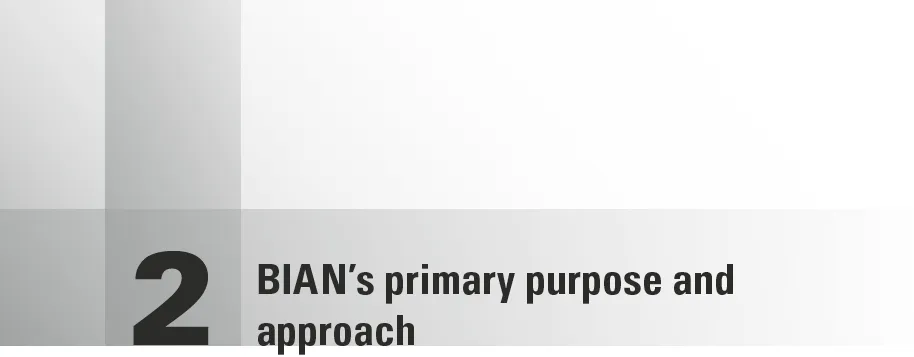![]()
![]()
■ 1.1 WHO THIS BOOK IS INTENDED FOR
This book is intended for those enterprise, business and solution architects in the financial services industry (FSI) who are interested in applying the BIAN Industry Standard in their organization. The authors of the book expect the readers to have an in-depth knowledge of IT architectural principles and methodologies.
For those architects and organizations already familiar with the TOGAF framework, we have added Appendix 2 which describes how one can apply the BIAN standard with the TOGAF framework.
■ 1.2 HOW TO USE THIS BOOK
This book will provide you with in-depth knowledge to help you understand the full construct of BIAN artifacts, how to apply them and how you can contribute to help the BIAN standard fulfill your (organization’s) needs. We will start with a short introduction to the BIAN organization, its goals, the deliverables and the future state.
Due to the constant development and evaluation of the BIAN models, additions to this publication will be publicly available at the BIAN homepage (www.bian.org).
This initial chapter gives you a high-level overview of all the topics that we will discuss in more detail in the designated chapters that follow:
■ Chapter 2: BIAN’s primary purpose and approach;
■ Chapter 3: Understanding the theory;
■ Chapter 4: The BIAN Service Landscape;
■ Chapter 5: How to apply the BIAN standard;
■ Chapter 6: Assembling a representative enterprise blueprint;
■ Chapter 7: An enterprise blueprint is a framework for analysis.
■ 1.3 BIAN, THE BANKING INDUSTRY ARCHITECTURE NETWORK
The Banking Industry Architecture Network (BIAN) is a global, not-for profit association of banks, solution providers, consultancy companies, integrators and academic partners with the shared aim of defining a semantic standard for the banking industry1 covering almost all the well-known architectural layers.
The BIAN was formed in 2008 by a group of banks and solution providers with the shared aim of defining a semantic Service Operation standard for the financial services industry. At a later stage other standards bodies, like ISO and IFX, joined along with some academic partners.
BIAN’s expectation is that a standard definition of business functions and service interactions that describe the general construct of any bank will be of significant benefit to the industry. When compared to an increasing number of proprietary designs, a dedicated industry standard, like BIAN, provides the following main benefits:
■ It enables the more efficient and effective development and integration of software solutions for and between banks;
■ It significantly lowers the overall integration costs;
■ It improves the operational efficiency within and between banks and provides the opportunity for greater solution and capability re-use within and among banks;
■ It supports the current need for more industry integration and collaboration through the usage of (open) APIs;
■ It supports the adoption of more flexible business service sourcing models and enhances the evolution and adoption of shared third party business services;
■ It supports FinTechs and RegTechs to gain an easy insight in the complex financial services industry structure.
BIAN refers to the collection of designs that makes up its industry standard known as the BIAN Service Landscape. The BIAN Service Landscape’s development is iterative, relying on the active contribution of industry participants to build consensus and encourage adoption. The BIAN Association coordinates the evolution of the BIAN Service Landscape on behalf of its members with regular new version releases and seeks feedback to help continually expand and refine its content.
It is helpful to understand that BIAN Working Groups govern Service Domains. Each Service Definition Working Group covers an associated area of business expertise. The scope covered by individual Working Groups is defined in their charter so that, collectively, Working Groups cover the whole landscape with no overlaps between them. The governance of Service Domains within a business area is assigned to a Working Group. The Working Group is then responsible for the initial specification and any subsequent updates to its assigned collection of Service Domains. This implies the content creation is driven by the BIAN members using their experts’ knowledge and experience.
■ 1.4 THE BIAN SERVICE LANDSCAPE, AN OVERVIEW
The BIAN Architecture is a layered/componentized one. These layers and components are identified in figure 1.
Figure 1: Components of the BIAN Service Landscape
This set of architectural artifacts is defined as the BIAN Service Landscape, it includes:
■ The BIAN Meta Model, based on the ISO 20022 Meta Model;
■ The BIAN Business Vocabulary;
■ The high-level BIAN reference map: the BIAN Service Landscape;
■ The BIAN Business Architecture;
■ The BIAN Business Capability Model;
■ The BIAN Service Domain Definitions;
■ The BIAN Service Operations Definitions;
■ The BIAN Business Scenario Definitions;
■ The BIAN Application Architecture;
■ The BIAN Application Capabilities (also called: Vendor Agnostic IT Model);
■ The BIAN API/Message Definitions;
■ The BIAN Information Architecture;
■ The BIAN Business Object Model, fully aligned with ISO 20022;
■ The BIAN API Classification Guideline.
The BIAN standard is published in a UML repository, as well as an HTML read-only version which is freely available on the BIAN website (https://www.bian.org/). In addition, a collection of supporting documents is maintained and released with each revised release of the BIAN standard.
The following options are in place to collect and process your feedback:
■ BIAN members are encouraged to provide feedback by using the BIAN Wiki, to the Architectural Committee, Architecture Framework & Foundation Working Group or via their representatives.
■ Non-members are invited to post their suggestions by using the BIAN website www.bian.org.
_________
![]()
■ 2.1 INTRODUCTION
Since 2008 the financial services industry has faced a series of challenges in respect to their business models, customer relations and information technology. The desired business changes in banks are often slowed down by an inflexible and complex systems landscape. The primary reason for the difficult transformation and modernization of that landscape is the fact that the components are tightly coupled.
The BIAN Association strives to enhance the flexibility and agility of financial services systems by improving the integration with an architecture that is based on services. Those financial services-specific semantic services are the cornerstone upon which to achieve this flexibility. The value of BIAN is the standardization of those functional services based on a well drafted architecture framework with elements carefully chosen from industry best practices. It is the ambition of the BIAN Association to achieve a consensus on the service definition among leading banks and providers in the financial services industry, which in due time should lead to standardized services.
The goal of the BIAN Association is to develop the most important content, concepts and methods in interoperability, supporting the aim of lower integration costs in the financial services industry and to facilitate business innovation and agility by:
■ Providing an architecture framework with all of the necessary elements, tools and methodologies for a sustainable operational model through the adoption of and alignment to available market standards.
■ Focusing on the definition of semantic services and/or API-definitions to improve the semantic integration of the financial services landscapes.
■ Enabling the financial services industry to develop and run successfully a loosely coupled environment.
■ Acceptance by the members of the BIAN Association and the industry of the way that the requirements will be implemented by both financial institutions and solution suppliers, resulting in the defined services becoming the de-facto-standard in the financial services industry.
■ 2.2 A DIFFERENT APPROACH TO A WELL-ESTABLISHED PROBLEM
Many financial services industry participants, including the founding members of the BIAN Association, have frequently observed a common and enduring problem: excessive complexity in most application portfolios. This complexity results in inflexible/unresponsive systems, inflated enhancement, increasing maintenance and operational costs, and an inability to leverage rapidly evolving advanced solutions, technologies, approaches and business models.
The BIAN Association was set up to address this issue by developing a common industry standard to define functional partitions and Service Operations that could be used inside any financial organization resulting in the anticipated benefits already noted. However, the objective of the BIAN Association raises a key question: “Why should the BIAN model and...




